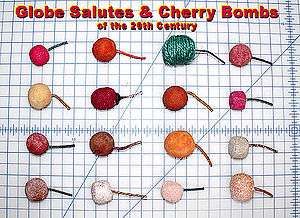Cherry bomb

A cherry bomb (also known as a globe salute, kraft salute or bangarang) is an approximately spherical exploding firework. Cherry bombs range in size from three-quarters of an inch to one and a half inches (1.9 cm to 3.8 cm) in diameter.
Composition
A typical cherry bomb contains a core of explosive composition (e.g., flash powder or, less commonly, black powder) which is generally encapsulated inside a paper cup, which is in turn most commonly surrounded by a layer (approx. one-quarter inch thick) of sawdust infused with a mild adhesive (usually sodium silicate). An ignition fuse is inserted into a hole drilled into the hardened sawdust sphere, all the way down to reach the explosive composition. The fuse extends outside the sphere approximately one to one and a half inches. Once the fuse is ignited, it takes about three to four and a half seconds to reach the explosive composition and initiate explosion of the firework.[2]
The color of the salute's exterior varies, depending on the manufacturer and the time period during which the salute was produced. Early on, in the late-1920s and 1930s, globe salutes had fuses which were tan, red or striped and multi-colored, and their body color varied, ranging from brown and tan to silver and red, and some were even decorated with multi-colored confetti. However, by the 1940s the most common color of the spherical salutes being marketed was a deep pink to red, with a green fuse, which is when the names cherry salute and cherry bomb entered popular use.[3]
Legal status
United States
These original spherical salutes were powerful enough to cause a legitimate safety concern. They were banned in the USA in 1966, by the federal Child Safety Act of 1966. Historically, these globe salutes and cherry bombs were made in two halves. One half was filled with powder and the other half was glued in place on top of it, and the whole globe was covered with glue-coated string or sawdust. This left an air-gap which created a louder bang when the case ruptured.[4] Another source says they were originally charged with 5 to 10 times the amount of explosive composition a standard inch-and-a-half paper firecracker had. After the enactment of the Child Safety Act of 1966, all "consumer fireworks" (those available to individuals), such as silver tube salutes, cherry bombs and M-80s were banned, and no firecracker or ground salute could contain more than 50 milligrams of powder mixture, which typically amounted to less than 5% of the original amount in a cherry bomb. The 50 mg law was passed in 1977.[5]
Original potency cherry bombs are considered explosive devices in the United States and possession, manufacture, or sale is illegal for individuals unless that individual has a license or permit issued by the Bureau of Alcohol, Tobacco, Firearms and Explosives.[6]
Popular culture
- The Who's drummer Keith Moon was famous for playing practical jokes involving cherry bombs during the band's tours during the 1960s onward. It is estimated that over the years, he caused around US$500,000 of damage to hotel toilets, resulting in his lifetime ban from Holiday Inn, Sheraton and Hilton hotel chains, including Hilton's Waldorf Astoria Hotels & Resorts. According to a biographer, he bought his first 500 cherry bombs in 1965. He later progressed to M-80s and even dynamite.
- "Cherry Bomb" was the first popular single from the eponymous album of the band The Runaways. It remains their best-selling single, and is ranked 52nd on VH1's 100 Greatest Hard Rock Songs.
- Popular sitcom Boy Meets World features a 1994 episode where the character Shawn Hunter blows up a mailbox with a cherry bomb.
- The Irish band Ash included a song named "Cherry Bomb" on their 2001 album Free All Angels.
- Singer and actress Kylie Minogue, wrote and recorded a song "Cherry Bomb" for her Mexican edition of 2007 album X and as B-side to singles "In My Arms" and "Wow".
- In 2015, Tyler, The Creator released an album titled Cherry Bomb.
- In 2017, South Korean band, NCT 127 released their third EP titled Cherry Bomb, with the title track also named Cherry Bomb.
See also
References
- ↑ "Globe Salutes & Cherry Bombs of the 20th Century, by John Chunko" (whitepaper, data sheet). J. Chunko. 2006.
- ↑ Donner, John (1997). "A Professional's Guide to Pyrotechnics". Paladin Press, Boulder, Colorado. ISBN 0-87364-929-X.
- ↑ Ronald Lancaster, MBE (1998). "Fireworks, Principles & Practice" (3 ed.). Chemical Publishing Co., Inc., New York. ISBN 0-8206-0354-6.
- ↑ 1965 Pyrotechnics Manufacturing Handbook
- ↑ "A Safe Practices Manual for the Manufacturing, Transportation, Storage & Use of Pyrotechnics, by U.S. Dept. of Health, Education & Welfare, Public Health Service, Center for Disease Control, National Inst. Of Occupational Safety and Health, Div. Of Safety Research (Request Government Publication: PB-297807)" (government publication, soft-cover reference book). National Technical Information Service, U.S. Dept. of Commerce, Springfield, VA 22161. 1977.
- ↑ "Fact Sheet - Illegal Explosive Devices". Bureau of Alcohol, Tobacco, Firearms and Explosives. 2016. Retrieved 2017-07-06.